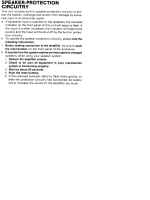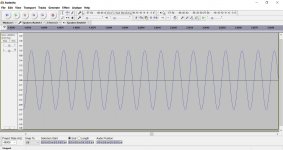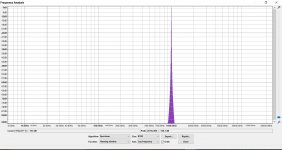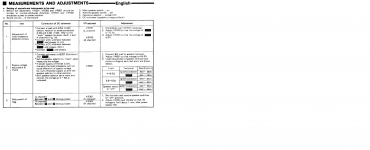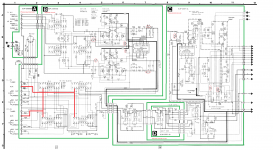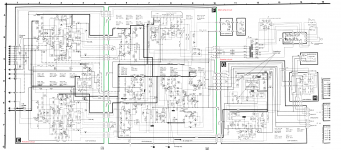They never flashed on my original set, the speakers are rated 100w and the amp 120w they really used to pump  this set, not so much not even close, "but"
this set, not so much not even close, "but"
that may be just because I am weary to push it whit the lights flashing.
You are spot on Mooly
that may be just because I am weary to push it whit the lights flashing.
You are spot on Mooly
Attachments
Clean transient peaks should do no harm at all to a speaker, the problems come when an amplifier clips the signal... and the reasons why that causes a problem are complex as it becomes an issue when the clipped signal raises the average power seen by the speaker, not simply that it is a clipped signal.
Yes, I think the amp need to be looked at plus the source input, ie PC is probably not as nice as a moving coil cartridge. I am not into changing records every 20 minutes these days.
I also noticed that I have to turn the volume to about 1to 1.5 before much sound is produced.
Would the whole amp need refurbishing or could I just do the part that I will be using, ie from the Aux input to the out put in direct coupled mode? Not to worried about phono or
via tone etc.
I might have ask these questions on the amp forum?
I also noticed that I have to turn the volume to about 1to 1.5 before much sound is produced.
Would the whole amp need refurbishing or could I just do the part that I will be using, ie from the Aux input to the out put in direct coupled mode? Not to worried about phono or
via tone etc.
I might have ask these questions on the amp forum?
Position of the volume control doesn't always tell much because it depends totally on the applied level of signal from the source.
If by refurbishing you mean changing old electrolytic caps then I suspect nothing much would change tbh. Ideally the amp should be checked with a scope and signal source to at least see that it produces a clean signal up to its power rating.
If by refurbishing you mean changing old electrolytic caps then I suspect nothing much would change tbh. Ideally the amp should be checked with a scope and signal source to at least see that it produces a clean signal up to its power rating.
I would normally recommend a cheap older analogue scope as a first purchase. 'Add on' USB type scopes for PC's usually aren't worth the bother for serious work.
If you really are only going to use it once, and then only to look at whether the amp is putting out a non distorted sine within the audio band then something really cheap might do the job.
It is at higher frequencies where USB and cheap handheld scopes and the like fall down, but if they can display up to say 50 or 100kHz then it would suffice for your needs.
A cheap old analogue scope would be looking at 20Mhz bandwidth as a minimum with bandwidths of typically 50 to 100Mhz pretty common.
The free program Audacity allows you to create test tones of all kinds in seconds and either save them as MP3 or WAV files or burn them to CDR.
Installing and using Audacity. A get you started guide.
If you really are only going to use it once, and then only to look at whether the amp is putting out a non distorted sine within the audio band then something really cheap might do the job.
It is at higher frequencies where USB and cheap handheld scopes and the like fall down, but if they can display up to say 50 or 100kHz then it would suffice for your needs.
A cheap old analogue scope would be looking at 20Mhz bandwidth as a minimum with bandwidths of typically 50 to 100Mhz pretty common.
The free program Audacity allows you to create test tones of all kinds in seconds and either save them as MP3 or WAV files or burn them to CDR.
Installing and using Audacity. A get you started guide.
Hi Mooly, There are cheap stand alone ones available, the problem with a second one, I would not know if it was working correctly. I could put a link up but that is probably not a good idea. Lots to choose from for around $100 or less.
I found today my computer was set on video sound quality so have corrected that and it has helped the sound a fair bit.
Thanks for the Audacity link I will check that out.
I will check that out.
I found today my computer was set on video sound quality so have corrected that and it has helped the sound a fair bit.
Thanks for the Audacity link
This is just an example there are others;
Rigol DS1054Z Digital Oscilloscopes - Bandwidth: 50 Mhz, Channels: 4 | eBay
Rigol DS1054Z Digital Oscilloscopes - Bandwidth: 50 Mhz, Channels: 4 | eBay
Rigol are a top brand... hmmm 
That would certainly do all you would want it to do and more with regard to audio work. Its limitations would be in dealing with complex waveforms at high frequencies (much higher than audio).
Its a lot to spend just for a one off measurement though... unless of course you wish to do more in the future.
This might help explain some of the details surrounding specifications.
That would certainly do all you would want it to do and more with regard to audio work. Its limitations would be in dealing with complex waveforms at high frequencies (much higher than audio).
Its a lot to spend just for a one off measurement though... unless of course you wish to do more in the future.
This might help explain some of the details surrounding specifications.
Attachments
I'll mention this for interest......
Audacity will allow you to record an audio waveform, be it music or a test tone, via the line input on a PC or laptop. You can then play that back, and not just as audio, you can 'look' at the waveform and also do basic fourier analysis.
This shows a 1kHz waveform viewed in Audacity and its spectrum.
So you could in theory record a couple of seconds of audio (test tone) and look at the result and see if the amp was distorting.
Because this is a pure test tone there are no harmonics (no distortion).
It is no oscilloscope replacement and has no value as a serious diagnostic tool but it would display a basic tone that you recorded.
Audacity will allow you to record an audio waveform, be it music or a test tone, via the line input on a PC or laptop. You can then play that back, and not just as audio, you can 'look' at the waveform and also do basic fourier analysis.
This shows a 1kHz waveform viewed in Audacity and its spectrum.
So you could in theory record a couple of seconds of audio (test tone) and look at the result and see if the amp was distorting.
Because this is a pure test tone there are no harmonics (no distortion).
It is no oscilloscope replacement and has no value as a serious diagnostic tool but it would display a basic tone that you recorded.
Attachments
Mainly that the overload lights flash on the speakers, not sure if it is the speakers or the amp is causing that, both about 38 years old. It could be possible the capacitors are past their best.
The overload LED flashes purely in response to applied voltage. It doesn't matter whether that comes from a faulty amp or the worlds finest... once the voltage threshold is reached the LED flashes.
If the amplifier isn't obviously distorting and showing other problems then its probably OK.
That's not to say that cap replacement on a near 40yr old item isn't worthwhile, just that it won't change the LED behaviour as such.
I hesitate to say yes, simply because if anything goes wrong then you could end up worse off......
The first two adjustments are unique to the amp (assume it is the Technics you mention in post #1) and tbh I've not seen anything like that on a design before.
I would want to look at the circuit diagram to see what the adjustments actually do and how they function.
The last adjustment is bias current and could be more critical than it seems because you may find it varies considerably with temperature.
Its your call on these
I would be happy doing all those once I had studied the circuit diagram and understood how it functions.
The first two adjustments are unique to the amp (assume it is the Technics you mention in post #1) and tbh I've not seen anything like that on a design before.
I would want to look at the circuit diagram to see what the adjustments actually do and how they function.
The last adjustment is bias current and could be more critical than it seems because you may find it varies considerably with temperature.
Its your call on these
I would be happy doing all those once I had studied the circuit diagram and understood how it functions.
- Home
- Loudspeakers
- Multi-Way
- Technics SB-10 Crossover Questions
